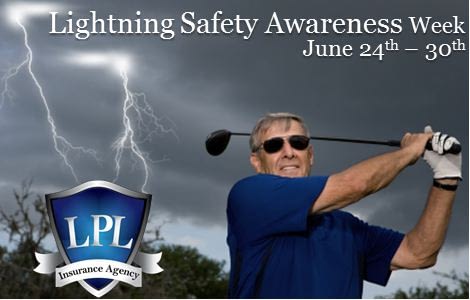Posted by LPL Risk Management on
![lightning awareness]() June 24-30 is Lightning Safety Awareness Week. According to the National Weather Service, lightning strikes account for an average of 54 deaths per year in the United States, so when thunderstorms are in the forecast, it’s usually a sign to head indoors and if you have to put away the golf clubs for a few hours or head in off of the lake to wait out the storm, it’s worth it. Here are some tips on what to do before, during and after a thunderstorm.
June 24-30 is Lightning Safety Awareness Week. According to the National Weather Service, lightning strikes account for an average of 54 deaths per year in the United States, so when thunderstorms are in the forecast, it’s usually a sign to head indoors and if you have to put away the golf clubs for a few hours or head in off of the lake to wait out the storm, it’s worth it. Here are some tips on what to do before, during and after a thunderstorm.
 June 24-30 is Lightning Safety Awareness Week. According to the National Weather Service, lightning strikes account for an average of 54 deaths per year in the United States, so when thunderstorms are in the forecast, it’s usually a sign to head indoors and if you have to put away the golf clubs for a few hours or head in off of the lake to wait out the storm, it’s worth it. Here are some tips on what to do before, during and after a thunderstorm.
June 24-30 is Lightning Safety Awareness Week. According to the National Weather Service, lightning strikes account for an average of 54 deaths per year in the United States, so when thunderstorms are in the forecast, it’s usually a sign to head indoors and if you have to put away the golf clubs for a few hours or head in off of the lake to wait out the storm, it’s worth it. Here are some tips on what to do before, during and after a thunderstorm.Before a thunderstorm
- Remove dead tree branches near your house which could ignite and cause a fire if
struck by lightning. - Unplug all appliances before the storm hits to prevent power surges.
- Close blinds and shades.
During a thunderstorm
- Keep away from windows.
- Avoid using the phone. Telephone lines can conduct electricity.
- Stay away from faucets, sinks and bathtubs.
- If you are in or near water, go to land immediately and find the best shelter you can—
preferably inside a building rather than a car. - If you’re in a car, keep the windows closed. Pull to the side of the road to wait until the
heavy rain subsides. Keep away from trees that could fall on your car. - If you are outside, find a location that is not likely to flood. Avoid tall structures, such
as towers, trees, fences, telephone lines or power lines. - Squat low to the ground and assume a tucked position. Place your hands on your knees
with your head tucked between them. Try to touch as little of your body to the ground as
possible. Do not lie flat on the ground, as your fully-extended body will provide a larger
surface to conduct electricity. - If you feel your hair stand on end in a storm, drop into the tuck position immediately.
This sensation means electrical charges are already running up your body from the
ground toward an electrically charged cloud. If you can minimize your contact with the
ground, you will minimize your injury.
After a thunderstorm
- Once lightning has struck a person or an object, the person or object does not carry a
charge and cannot harm you. So don’t be afraid to touch or assist a person who needs
help. Administer first aid or CPR immediately. A lightning victim usually suffers burns
in two places on the body—where the lightning entered and where it exited.
From Trusted Choice
Tagged With: Lightning Safety Awareness Week., storm safety, summer storms, thunder storm, what to do after a thunderstorm